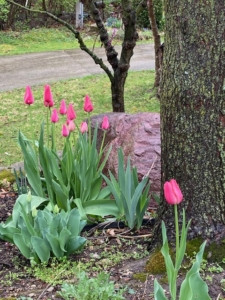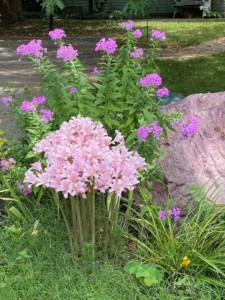Are Pink Rocks Rare? No, pink rocks are not necessarily rare, as their presence depends largely on geographical location and geological composition. At rockscapes.net, we help you discover where to find them and how to incorporate these unique geological features into your landscape. Pink rocks add a touch of natural elegance to any setting.
1. Understanding Pink Rocks: Composition and Formation
1.1. What Makes Rocks Pink?
What makes rocks pink? The pink hue in rocks primarily comes from the presence of minerals like iron oxide (hematite), manganese, or the mineral potassium feldspar (like orthoclase or microcline). Iron oxide coats the grains of the rock, resulting in a reddish or pinkish tone, similar to rust on metal. According to research from Arizona State University’s School of Earth and Space Exploration, the concentration and distribution of these minerals significantly influence the intensity and uniformity of the pink color.
1.2. Common Types of Pink Rocks
What are some common types of pink rocks? Pink rocks come in various forms. Some common types are:
- Rose Quartz: Known for its delicate pink color and often used in jewelry and decorative items.
- Pink Granite: A durable and popular choice for countertops and building materials, often speckled with other minerals.
- Rhyolite: This extrusive igneous rock can exhibit beautiful pink shades due to its mineral composition.
- Sandstone: Sedimentary rock that acquires a pink color from iron oxide.
1.3. Geological Processes Contributing to Pink Rocks
What geological processes contribute to the creation of pink rocks? Several geological processes contribute to the formation of pink rocks, including:
- Igneous Activity: During the cooling and solidification of magma or lava, minerals such as potassium feldspar can crystallize, imparting a pink color to the resulting rock.
- Sedimentary Deposition: Iron oxide can precipitate out of water and coat sedimentary grains, leading to the formation of pink sandstone or shale.
- Metamorphism: Existing rocks can undergo changes in mineral composition and texture when subjected to high pressure and temperature, sometimes resulting in the development of pink hues.
 Pink Granite Boulders
Pink Granite Boulders
2. Where Can You Find Pink Rocks?
2.1. Geographical Locations Known for Pink Rocks
Where can you find pink rocks geographically? Certain regions are renowned for their abundance of pink rocks:
- South Dakota, USA: Known for its Sioux Quartzite, used extensively in landscaping and construction.
- Minnesota, USA: Like South Dakota, Minnesota has pink rocks due to glacial deposit.
- Western Australia: Features pink granite formations in areas like Wave Rock.
- Canada: Several locations have pink granite, particularly in the Canadian Shield.
2.2. Specific Geological Formations Featuring Pink Rocks
What specific geological formations feature pink rocks? Specific geological formations often showcase stunning pink rock formations:
- Sioux Quartzite Quarries: Quarries in South Dakota and Minnesota are prime locations.
- National Parks: Parks like Arches National Park have pink sandstone formations.
- Coastal Regions: Some coastal areas feature pink granite cliffs and beaches.
2.3. Factors Influencing the Distribution of Pink Rocks
What factors influence the distribution of pink rocks? Several factors influence the distribution of pink rocks:
- Geological History: Regions with a history of volcanic activity or sedimentary deposition are more likely to have pink rocks.
- Mineral Availability: The presence of iron oxide, manganese, and potassium feldspar influences the formation of pink rocks.
- Erosion and Weathering: These processes expose pink rock formations and make them more visible.
3. The Allure of Pink Rocks: Aesthetics and Symbolism
3.1. Aesthetic Appeal in Landscaping
Why are pink rocks aesthetically appealing in landscaping? Pink rocks add a unique and eye-catching element to landscape designs. Their soft, warm tones contrast beautifully with greenery, creating a harmonious and visually pleasing environment.
3.2. Symbolism and Meaning Associated with Pink Rocks
What symbolism and meaning are associated with pink rocks? Pink rocks are often associated with love, compassion, and healing. In feng shui, rose quartz is used to promote emotional balance and harmony.
3.3. Cultural Significance of Pink Rocks
What is the cultural significance of pink rocks? In some cultures, pink stones are believed to have protective properties and are used in rituals and ceremonies. For instance, certain Native American tribes use pink quartzite in sacred ceremonies.
 Pink Rocks in Garden
Pink Rocks in Garden
4. Using Pink Rocks in Landscaping: Ideas and Inspiration
4.1. Incorporating Pink Rocks into Garden Designs
How can I incorporate pink rocks into garden designs? There are numerous ways to incorporate pink rocks into garden designs:
- Rock Gardens: Create a rock garden featuring various sizes and shapes of pink rocks.
- Pathways: Use crushed pink rock to create pathways that add color and texture to your garden.
- Borders: Outline flower beds or walkways with larger pink rocks to define spaces.
- Water Features: Incorporate pink rocks around ponds or fountains for a natural, elegant look.
- Accent Pieces: Use large pink boulders as focal points in your landscape.
4.2. DIY Projects Featuring Pink Rocks
What DIY projects can I do featuring pink rocks? Several DIY projects can showcase the beauty of pink rocks:
- Painted Rocks: Decorate pink rocks with paint and use them as garden markers or decorative accents.
- Rock Stacking: Create rock stacks as unique garden sculptures.
- Miniature Gardens: Build miniature gardens in containers using small pink rocks and succulents.
4.3. Combining Pink Rocks with Other Landscaping Elements
What other landscaping elements combine well with pink rocks? Pink rocks pair well with various landscaping elements:
- Greenery: Contrast pink rocks with lush green plants for a vibrant display.
- Water: Combine pink rocks with water features to enhance their natural beauty.
- Lighting: Use landscape lighting to highlight the texture and color of pink rocks at night.
5. Sourcing and Selecting Pink Rocks: Quality and Sustainability
5.1. Identifying High-Quality Pink Rocks
How do I identify high-quality pink rocks? Look for rocks with uniform color, minimal imperfections, and a smooth texture. Ensure they are free of cracks or weaknesses that could compromise their durability.
5.2. Sustainable Sourcing Practices for Pink Rocks
What are sustainable sourcing practices for pink rocks? Choose suppliers who follow sustainable mining practices to minimize environmental impact. Look for certifications that indicate responsible sourcing.
5.3. Reputable Suppliers of Pink Rocks in the USA
Who are reputable suppliers of pink rocks in the USA? Check out local stone yards and landscape suppliers for options. Some reputable suppliers include:
- Local Stone Yards: These often carry a variety of pink rocks sourced from regional quarries.
- Online Retailers: Websites specializing in landscaping materials can offer a wide selection of pink rocks.
- Rockscapes.net: Your premier source for high-quality pink rocks and landscaping advice.
6. Maintenance and Care of Pink Rocks in Landscapes
6.1. Cleaning and Preserving Pink Rocks
How do I clean and preserve pink rocks? Clean pink rocks with water and a soft brush to remove dirt and debris. Avoid using harsh chemicals that could damage the stone. Applying a sealant can help preserve their color and protect them from weathering.
6.2. Preventing Discoloration and Staining
How do I prevent discoloration and staining of pink rocks? Prevent discoloration and staining by avoiding contact with acidic substances, such as fertilizers or cleaning solutions. Ensure proper drainage to prevent water from pooling around the rocks.
6.3. Long-Term Care Tips for Pink Rock Landscapes
What are some long-term care tips for pink rock landscapes? Periodically inspect your pink rock landscapes for signs of damage or wear. Replace any damaged rocks and replenish gravel or mulch as needed to maintain the aesthetic appeal of your landscape.
 Pink Rocks Along Train Tracks
Pink Rocks Along Train Tracks
7. The Science Behind Pink Rocks: Geology and Mineralogy
7.1. The Geological Formation of Pink Quartzite
What is the geological formation of pink quartzite? Pink quartzite, like Sioux Quartzite, forms from sandstone that undergoes metamorphism. During this process, the sand grains fuse together under high pressure and temperature, creating a dense, durable rock. The pink color comes from iron oxide present during the formation.
7.2. Mineral Composition of Pink Granite
What is the mineral composition of pink granite? Pink granite primarily consists of quartz, feldspar (especially potassium feldspar), and small amounts of mica and other minerals. The potassium feldspar gives the granite its pink color.
7.3. The Role of Iron Oxide in Pink Rock Coloration
What is the role of iron oxide in pink rock coloration? Iron oxide coats the grains of the rock, creating a reddish or pinkish tone. The intensity of the color depends on the concentration and distribution of the iron oxide.
8. Case Studies: Successful Pink Rock Landscaping Projects
8.1. Residential Landscaping with Pink Rocks
What are some residential landscaping projects using pink rocks? Many homeowners have successfully incorporated pink rocks into their landscapes:
- Rock Gardens: Creating striking rock gardens with various sizes and shapes of pink rocks.
- Pathways: Building pathways with crushed pink rock to add color and texture.
- Accent Pieces: Using large pink boulders as focal points in the yard.
8.2. Commercial Landscaping with Pink Rocks
What are some commercial landscaping projects using pink rocks? Businesses often use pink rocks to enhance their curb appeal:
- Office Buildings: Incorporating pink rocks into landscaping around office buildings.
- Shopping Centers: Using pink rocks to create visually appealing entrance areas.
- Parks: Adding pink rocks to park landscapes for a touch of color and elegance.
8.3. Public Spaces Featuring Pink Rock Formations
What public spaces feature pink rock formations? Public spaces like parks and gardens often showcase pink rock formations:
- Sioux Falls, South Dakota: The city’s namesake falls feature pink quartzite formations.
- Arches National Park: The park features stunning pink sandstone arches and formations.
9. Trends in Pink Rock Landscaping: What’s New and Popular
9.1. Latest Design Trends Featuring Pink Rocks
What are the latest design trends featuring pink rocks? Current trends include:
- Minimalist Designs: Using pink rocks sparingly to create clean, modern landscapes.
- Xeriscaping: Incorporating pink rocks into drought-tolerant landscapes.
- Native Plant Pairings: Combining pink rocks with native plants for a natural, sustainable look.
9.2. Innovative Uses of Pink Rocks in Modern Landscapes
What are some innovative uses of pink rocks in modern landscapes? Innovative uses include:
- Vertical Gardens: Using pink rocks as a backdrop for vertical gardens.
- Sculptural Elements: Creating sculptural elements with pink rocks to add artistic flair.
- Fire Features: Incorporating pink rocks around fire pits or fireplaces for a warm, inviting ambiance.
9.3. The Future of Pink Rock Landscaping
What is the future of pink rock landscaping? The future of pink rock landscaping is bright, with continued innovation and appreciation for their natural beauty. As sustainable landscaping practices become more popular, pink rocks will play an increasingly important role in creating visually stunning and environmentally friendly landscapes.
10. Expert Opinions: Insights from Landscaping Professionals
10.1. Perspectives from Landscape Architects
What are the perspectives from landscape architects? Landscape architects value pink rocks for their versatility and aesthetic appeal. They often use them to create unique and eye-catching designs that enhance the beauty of outdoor spaces.
10.2. Tips from Garden Designers
What are some tips from garden designers? Garden designers recommend:
- Consider Scale: Choose rocks that are appropriately sized for your landscape.
- Create Contrast: Pair pink rocks with contrasting colors and textures.
- Add Depth: Use layers of pink rocks to create depth and dimension.
10.3. Advice from Geologists on Selecting Pink Rocks
What is some advice from geologists on selecting pink rocks? Geologists advise:
- Check Composition: Ensure the rocks are composed of durable minerals.
- Inspect for Weaknesses: Look for cracks or weaknesses that could compromise their integrity.
- Consider Origin: Choose rocks from reputable sources that follow sustainable mining practices.
11. Addressing Common Misconceptions About Pink Rocks
11.1. Dispelling Myths About the Rarity of Pink Rocks
What are some myths about the rarity of pink rocks? While some pink rocks are rare, many types are relatively common, especially in regions with a history of volcanic activity or sedimentary deposition.
11.2. Clarifying Misunderstandings About the Composition of Pink Rocks
What are some misunderstandings about the composition of pink rocks? Some people mistakenly believe that all pink rocks are rose quartz. In reality, pink rocks can be composed of various minerals, including feldspar, granite, and quartzite.
11.3. Debunking Common Misconceptions About the Use of Pink Rocks in Landscaping
What are some misconceptions about the use of pink rocks in landscaping? Some people believe that pink rocks are only suitable for certain types of landscapes. However, pink rocks can be incorporated into a wide range of designs, from minimalist gardens to elaborate rock gardens.
12. The Environmental Impact of Using Pink Rocks in Landscaping
12.1. Assessing the Environmental Footprint of Sourcing Pink Rocks
What is the environmental footprint of sourcing pink rocks? The environmental footprint of sourcing pink rocks can vary depending on the mining practices used. Sustainable sourcing practices can minimize environmental impact.
12.2. Sustainable Mining Practices for Pink Rocks
What are sustainable mining practices for pink rocks? Sustainable mining practices include:
- Reducing Waste: Minimizing waste by using efficient mining techniques.
- Rehabilitating Sites: Restoring mined areas to their natural state.
- Conserving Water: Using water responsibly during mining operations.
12.3. Tips for Minimizing Environmental Impact When Using Pink Rocks
What are some tips for minimizing environmental impact when using pink rocks? Minimize environmental impact by:
- Choosing Local Suppliers: Selecting suppliers who source rocks from nearby quarries.
- Using Recycled Materials: Incorporating recycled materials into your landscape design.
- Conserving Water: Using drought-tolerant plants and efficient irrigation systems.
13. Pink Rocks in Art and Architecture
13.1. Pink Rocks as a Medium for Sculpture
How are pink rocks used as a medium for sculpture? Sculptors use pink rocks to create unique and eye-catching works of art. The natural beauty of the stone enhances the artistic expression.
13.2. Pink Rocks in Building Facades and Design
How are pink rocks used in building facades and design? Architects incorporate pink rocks into building facades and design elements to add color and texture to structures.
13.3. Famous Landmarks Featuring Pink Rocks
What are some famous landmarks featuring pink rocks? Famous landmarks featuring pink rocks include:
- Government Buildings: Some government buildings feature pink granite facades.
- Museums: Museums often showcase pink rock sculptures and architectural elements.
- Historic Sites: Historic sites may feature pink rock formations or structures.
14. Exploring Pink Rock Formations: A Traveler’s Guide
14.1. Best Destinations for Viewing Pink Rocks
What are the best destinations for viewing pink rocks? The best destinations for viewing pink rocks include:
- South Dakota, USA: Home to the famous Sioux Quartzite formations.
- Western Australia: Known for Wave Rock and other pink granite formations.
- Arches National Park, USA: Features stunning pink sandstone arches and formations.
14.2. Tips for Planning a Pink Rock Excursion
What are some tips for planning a pink rock excursion? Tips for planning a pink rock excursion include:
- Research Locations: Identify specific sites known for pink rock formations.
- Check Weather Conditions: Plan your trip during favorable weather conditions.
- Pack Essentials: Bring water, sunscreen, and comfortable hiking shoes.
14.3. What to Expect When Visiting Pink Rock Sites
What should I expect when visiting pink rock sites? Expect to see stunning natural landscapes featuring unique pink rock formations. Be prepared for varying terrain and weather conditions. Respect the environment and follow all posted rules and regulations.
15. The Business of Pink Rocks: Mining, Sales, and Distribution
15.1. The Pink Rock Mining Industry
What is the pink rock mining industry like? The pink rock mining industry involves extracting pink rocks from quarries and mines. The industry is subject to environmental regulations and sustainability concerns.
15.2. Market Trends in Pink Rock Sales
What are some market trends in pink rock sales? Market trends include:
- Increased Demand: Growing demand for pink rocks in landscaping and construction.
- Sustainable Sourcing: Greater emphasis on sustainable sourcing practices.
- Online Sales: Rising popularity of online sales of pink rocks.
15.3. How to Start a Pink Rock Landscaping Business
How can I start a pink rock landscaping business? To start a pink rock landscaping business:
- Develop a Business Plan: Create a detailed business plan outlining your goals and strategies.
- Secure Funding: Obtain funding through loans, grants, or investors.
- Build a Network: Establish relationships with suppliers, contractors, and customers.
 Pink Rocks in Campground Driveway
Pink Rocks in Campground Driveway
FAQ: Frequently Asked Questions About Pink Rocks
1. What gives rocks their pink color?
The pink color in rocks primarily comes from minerals like iron oxide (hematite) or potassium feldspar.
2. Is pink granite rare?
Pink granite is not particularly rare, but its availability depends on the region.
3. Where can I find pink quartzite?
Pink quartzite is commonly found in South Dakota and Minnesota, USA.
4. How do I clean pink rocks in my garden?
Clean pink rocks with water and a soft brush. Avoid harsh chemicals.
5. Are pink rocks safe for water features?
Yes, pink rocks are generally safe for water features, but ensure they are clean and free of contaminants.
6. Can I paint pink rocks?
Yes, you can paint pink rocks with acrylic paints for decorative purposes.
7. How do I prevent pink rocks from fading?
Apply a sealant to protect pink rocks from weathering and UV damage.
8. What are the best plants to pair with pink rocks?
Pair pink rocks with greenery, succulents, and native plants for a visually appealing landscape.
9. Are there any spiritual meanings associated with pink rocks?
Pink rocks, especially rose quartz, are often associated with love, compassion, and healing.
10. How do I choose sustainable pink rocks?
Choose suppliers who follow sustainable mining practices and offer certified products.
Pink rocks offer a unique and captivating element to any landscape, adding a touch of elegance and natural beauty. Whether you’re looking to create a serene rock garden, a vibrant pathway, or a stunning focal point, incorporating pink rocks can transform your outdoor space into a picturesque retreat.
Ready to explore the possibilities of pink rocks in your landscape? Visit rockscapes.net for inspiration, expert advice, and a wide selection of high-quality pink rocks to bring your vision to life. Let us help you create a landscape that reflects your unique style and enhances the beauty of your home. Contact us today at Address: 1151 S Forest Ave, Tempe, AZ 85281, United States or Phone: +1 (480) 965-9011.
